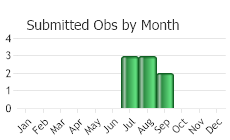View in other NatureServe Network Field Guides
NatureServe
Montana
Utah
Wyoming
Idaho
Wisconsin
British Columbia
South Carolina
Yukon
California
New York
Kruckeberg's Swordfern - Polystichum kruckebergii
Other Names:
Kruckeberg's Hollyfern
State Rank Reason (see State Rank above)
Sparsely distributed across western Montana on alpine and subalpine cliffs and talus slopes. Very little data are available for the locations in Montana, though the habitats occupied by the species are not generally impacted by human activities or disturbance. Additional survey and monitoring data are needed.
- Details on Status Ranking and Review
Population Size
Score2-3 - Very Small to Small: Population size is imprecisely known but is believed to be <10,000 individuals.
CommentEstimated. Available population data are limited and imprecise.
Range Extent
Score1 - Peripheral, Disjunct or Sporadic Distribution in MT: Widespread species that is peripheral, disjunct or sporadically distributed within MT such that it occurs in <5% of the state (<7,500 sq. miles or the combined area of Beaverhead and Ravalli Counties) or is restricted to 4-5 sub-basins.
Area of Occupancy
Score2 - Low: Generally occurring in 4-10 Subwatersheds (6th Code HUC’s).
Environmental Specificity
Score1 - Moderate: Species is restricted to a specific habitat that is more widely distributed or to several restricted habitats and is typically dependent upon relatively unaltered, good-quality habitat (C Values of 5-7).
Trends
Score0-2 - Stable to Moderate Declines:
CommentTrends are unknown, though the species probably has not experienced significant declines in Montana.
Threats
Score1 - Medium: 11-30% of the populations are being negatively impacted or are likely to be impacted by one or more activities or agents, which are expected to result in decreased populations and/or habitat quality and/or quantity.
CommentHabitat is generally remote, limiting the potential for negative impacts.
Intrinsic Vulnerability
Score1-2 - Moderate to High Vulnerability.
Raw Conservation Status Score
Score
8 to 12 total points scored out of a possible 19.
General Description
Polystichum kruckebergii has evergreen fronds that are 9-35 cm long and clustered on a short, ascending rhizome. Each frond consists of a scale-covered petiole, or stipe, that is 2-11 cm long and a narrowly lance-shaped blade, or lamina, that is 7-23 cm long and deeply lobed into 20-40 leaflets, or pinnae. Each pinna has a toothed and spiny margin, and the lower ones are lobed at the base. Spores are borne in small clusters, or sori, that are partially covered by a membranous disk, or indusium, that is located on the undersides of the upper pinnae.
Phenology
Mature fronds in August.
Diagnostic Characteristics
This species is distinguished from the common Polystichum lonchites by the lobed basal pinnae and from P. scopulinum by the spiny pinnae margins.
Species Range
Montana Range
Range Descriptions

 Native
Native
Range Comments
In MT known only from Lake, Flathead, Deer Lodge, Carbon and Gallatin counties; BC to MT south to CA and UT (Lesica et al. 2012. Manual of Montana Vascular Plants. BRIT Press. Fort Worth, TX; herbarium specimen data provided by University of Washington and Montana State University (accessed through the Consortium of Pacific Northwest Herbaria website, www.pnwherbaria.org, 2010-10-02)).
Observations in Montana Natural Heritage Program Database
Number of Observations: 8
(Click on the following maps and charts to see full sized version)
Map Help and Descriptions
Relative Density

Recency



 (Observations spanning multiple months or years are excluded from time charts)
(Observations spanning multiple months or years are excluded from time charts)
Habitat
Cliff crevices and talus slopes in montane to alpine zones.
Ecological Systems Associated with this Species
Threats or Limiting Factors
STATE THREAT SCORE REASON
Threat impact not assigned because threats are not known (MTNHP Threat Assessment 2021).
References
- Literature Cited AboveLegend:
 View Online Publication
View Online Publication Lesica, P., M.T. Lavin, and P.F. Stickney. 2012. Manual of Montana Vascular Plants. Fort Worth, TX: BRIT Press. viii + 771 p.
Lesica, P., M.T. Lavin, and P.F. Stickney. 2012. Manual of Montana Vascular Plants. Fort Worth, TX: BRIT Press. viii + 771 p.
- Additional ReferencesLegend:
 View Online Publication
View Online Publication
Do you know of a citation we're missing? Achuff, P. L. and L. S. Roe. 1992. Botanical survey of the Goat Flat proposed Research Natural Area, Deerlodge National Forest. Unpublished report to the Deerlodge National Forest. Montana Natural Heritage Program, Helena, MT. 31 pp.
Achuff, P. L. and L. S. Roe. 1992. Botanical survey of the Goat Flat proposed Research Natural Area, Deerlodge National Forest. Unpublished report to the Deerlodge National Forest. Montana Natural Heritage Program, Helena, MT. 31 pp. Lackschewitz, K. H. 1976. Montana mountain flora: new records. Madrono 23:360-362.
Lackschewitz, K. H. 1976. Montana mountain flora: new records. Madrono 23:360-362. Lellinger, D.B. 1985. A Field Manual of the Ferns and Fern-Allies of the United States and Canada. Smithsonian Inst. Press. Washington, D.C. B85LEL01PAUS
Lellinger, D.B. 1985. A Field Manual of the Ferns and Fern-Allies of the United States and Canada. Smithsonian Inst. Press. Washington, D.C. B85LEL01PAUS Lesica, P., M.T. Lavin, and P.F. Stickney. 2022. Manual of Montana Vascular Plants, Second Edition. Fort Worth, TX: BRIT Press. viii + 779 p.
Lesica, P., M.T. Lavin, and P.F. Stickney. 2022. Manual of Montana Vascular Plants, Second Edition. Fort Worth, TX: BRIT Press. viii + 779 p.
- Web Search Engines for Articles on "Kruckeberg's Swordfern"





